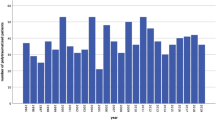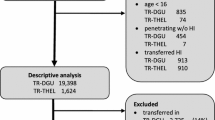Summary
Worldwide there will be an increase in polytraumatized patients. The number of death after trauma will increase from 5,1 Mill. to 8,4 Mill. The reason is the technical progress in the third world. In western countries there was a decrease in trauma death, in Germany below 8.000 due to traffic accidents in 1998. In most countries the paramedic system and ATLS are established (USA, South Africa). Long rescue times and inadequate shock treatment preclinically are the bigest problems in Russia and Greece. Worldwide the institution of trauma centers (Level I, II, III) has brought much better results comparing to nontrauma centers but is economically expensive. The annual number of polytraumatized patients (Level I 600–1.000 severe trauma, > 65 personal experience) is essential for the success rate. Infrastrucure, Algorithmus and the personal experience of the trauma leader are the keys for optimal results. One parameter for Quality measurement is the number of potentially preventable deaths. Retrospective analysis of treatment protocols and pathological results by an expert team is the best practical way. The results of level I trauma teams reach between 1 and 2 % preventable deaths. A further instrument of quality improvement are Trauma registers like in US and England (MTOS) and the German Trauma register of the German Society of Trauma. The Trauma register in Germany contents till now 2.069 polytraumatized patients.The lethality is 18,6 % (ISS 21 ± 13), comparing to MTOS (ISS 12,8 ± 11,3, lethality 9,2 %). The differences in injury pattern show in the US three times more penetrating injuries than in the German Traumaregister (21,1 % versus 7,2 %).
Zusammenfassung
Weltweit wird es bis zum Jahr 2020 zu einem erheblichen Anstieg der Verletztenzahlen und Unfalltoten von derzeit 5,1 auf 8,4 Mio. kommen. Die Ursache liegt vor allen Dingen in der rasanten technischen Entwicklung innerhalb der 3. Welt. In den westlichen Ländern ging die Zahl der Unfalltoten in den letzten Jahren zurück, 1998 in Deutschland auf den niedrigsten Stand mit unter 8.000 Unfalltoten. International bestehen noch erhebliche Unterschiede in der präklinischen Versorgung der Polytraumen. In vielen Ländern ist das Paramedicsystem mit ATLS-Schulung etabliert (USA, Südafrika). Lange Rettungszeiten und unzureichende präklinische Schockbehandlung sind die Hauptprobleme der Unfallopfer (z. B. Rußland, in Teilen Griechenlands). Die Etablierung von Traumazentren hat sich weltweit als medizinisch erfolgreich, aber ökonomisch aufwendig erwiesen. Entscheidend für die Ergebnisse ist das jährliche Aufkommen von Polytraumen in derartigen Zentren. Gefordert werden für Level-1-Traumazentren in den USA zwischen 600 und 1.000 schwere Traumen mit einem persönlichen Erfahrungsschatz von mindestens 65 Polytraumen pro Jahr. Infrastruktur, Algorithmen und die persönliche Erfahrung des Traumaleaders sind, weltweit durch viele Studien belegt, was eine Voraussetzung für die Messung der Ergebnisqualität darstellt. Ein meßbarer Qualitätsfaktor ist die Zahl potentiell vermeidbarer Todesfälle. Die Analyse der Krankengeschichten und Sektionsergebnisse von einem unabhängigen Expertenteam hat sich dabei als bestes Kriterium erwiesen. Die Ergebnisse der Level-1-Traumazentren variieren zwischen 1 und 2 % vermeidbarer Todesfälle. Ein weiteres Instrument der Qualitätsverbesserung sind Traumaregister, wie das MTOS in den USA und England und das Deutsche Traumaregister der Deutschen Gesellschaft für Unfallchirurgie. Das Traumaregister in Deutschland umfaßt bisher 2.069 Schwerverletzte. Die Letalität betrug 18,6 % bei einem Injury Severity Score nach Baker (ISS) von 21 ± 13. In der MTOS-Studie betrug der ISS 12,8 ± 11,3, die Letalität 9,2 %. Die Unterschiede im Verletzungsmuster zeigen in den USA einen dreimal so hohen Anteil penetrierender Traumen in der MTOS-Studie (21,1 gegenüber 7,2 %).
Similar content being viewed by others
Author information
Authors and Affiliations
Rights and permissions
About this article
Cite this article
Oestern, HJ. International comparison of the treatment of polytraumatized patients. Unfallchirurg 102, 80–91 (1999). https://doi.org/10.1007/s001130050378
Published:
Issue Date:
DOI: https://doi.org/10.1007/s001130050378




